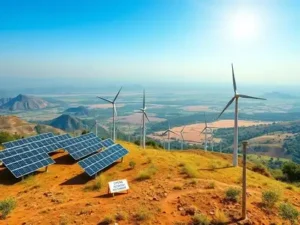GS3 – Environment

Context:
India has successfully achieved 50.08% of its total installed power capacity from non-fossil sources, reaching its 2030 Nationally Determined Contributions (NDC) target five years ahead of schedule.
Installed Capacity Profile (as of June 2025):
| Source | Capacity (GW) | Share (%) |
| Thermal (Coal, Gas) | 242.04 | 49.92 |
| Nuclear | 8.78 | 1.81 |
| Large Hydro | 49.38 | 10.19 |
| Renewable Energy | 184.62 | 38.08 |
| Total Non-Fossil | 242.78 | 50.08 |
| Total Capacity | 484.82 | 100.00 |
Structural Enablers of Progress:
- Policy Framework: Clear targets and long-term planning enhanced investor confidence.
- Cost Advantage: Reverse auctions led to low tariffs and rapid project implementation.
- Decentralisation: Rooftop solar initiatives scaled through schemes like PM-KUSUM and PM Surya Ghar.
- Bioenergy: Integration of biomass projects enabled use of agro-residues and dispatchable energy.
- Green Finance: Use of green bonds and concessional funding improved economic viability.
Policy & Scheme Support:
- PM-KUSUM: Promotes solar energy for agricultural purposes.
- PM Surya Ghar: Muft Bijli Yojana: Offers free rooftop solar to one crore households.
- Solar Park Scheme: Facilitates utility-scale solar projects with land and grid assistance.
- National Wind-Solar Hybrid Policy: Enhances efficiency through hybrid power plants.
- National Green Hydrogen Mission: Aims to produce 5 MTPA of green hydrogen by 2030.
- PLI for Solar PVs: Supports domestic manufacturing of solar modules and cells.
Forward-Looking Strategy:
- Quality & Resilience: Emphasize standards, climate-resilience, and equitable energy access.
- Higher Consumption: Goal to double per capita clean energy use by 2030.
- Grid Modernisation: Invest in smart grids for managing variability and bidirectional flows.
- Storage Solutions: Expand battery and pumped hydro storage.
- Circular Economy: Encourage recycling of solar, wind, and battery components.
- Green Hydrogen Expansion: Invest in electrolyser capacity and hydrogen-based industries.
Panchamrita Commitments (COP26, Glasgow):
- 500 GW non-fossil electricity capacity by 2030
- 50% of total energy from renewables
- 45% reduction in emission intensity of GDP (from 2005)
- Reduction of 1 billion tonnes of projected emissions by 2030
- Net-zero carbon emissions by 2070




